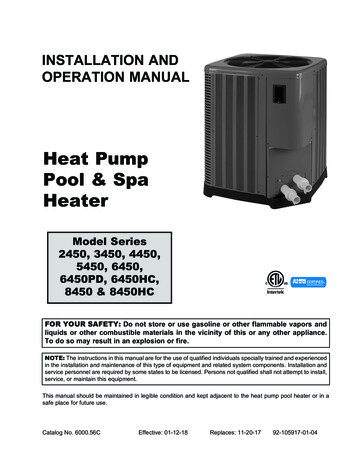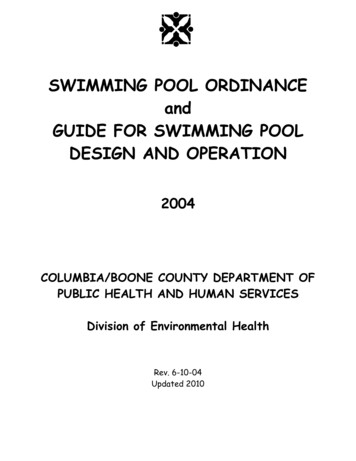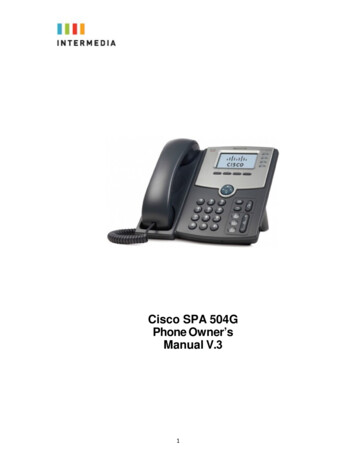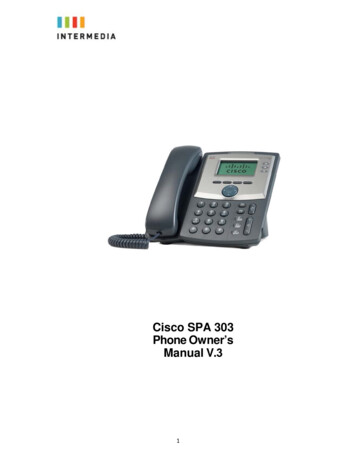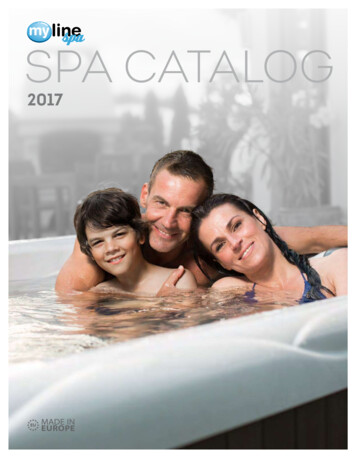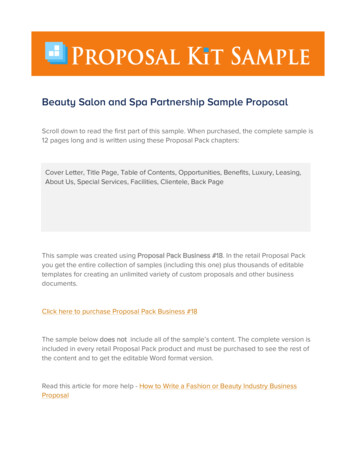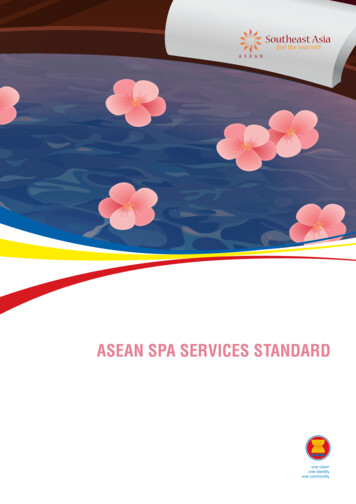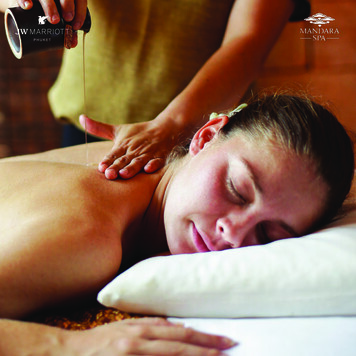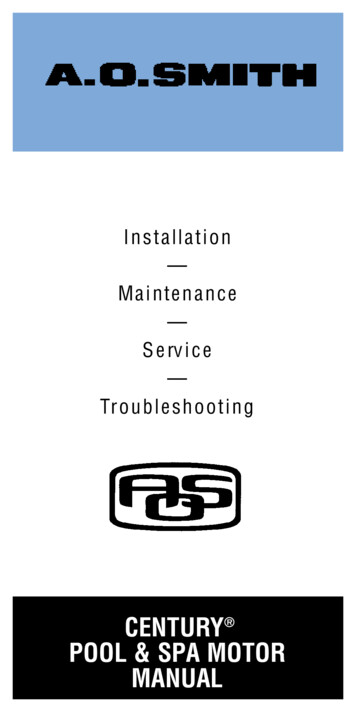
Transcription
Installation—Ma i nte n a n ce—S e rv i c e—Tro u b l e s h o o t i n gCENTURY POOL & SPA MOTORMANUAL
INTRODUCTIONelcome to A.O. Smith’s line of Century Motors. This pocket manual is designed forone purpose — to make it simple for you toinstall, maintain and troubleshoot Century pool andspa motors. Contrary to what you may be thinking justnow, your last name doesn’t have to be Edison in order toproperly service the motors shown in the following pages.All you need are a few basic tools and some helpful hints;the kind that appear throughout thisbooklet.We’ve included all the information we think you’llneed to repair the most common pump motor problemsencountered out in the field. This easy to read manual contains great illustrations and diagrams for quickreference. Assisting your customers is your job. Helpingyou do that with minimum delay is our job; that’s whywe’ve prepared this informative manual.W1
Replacements for every brand. Every now and thenyou probably come across a motor that’s beyond repair.When you do, remember that A.O. Smith manufacturesreplacement pool and spa motors for practically everybrand you’ll ever encounter in the field. So save yourselfsome time and effort and just ask for Century first — atany A.O. Smith distributor or dealer. Century motors are asrugged as any you’ll find, but keep in mind that all motorsneed service and maintenance at one time or another.Safety first. Remember, before you begin to work onany electrical appliance be sure to TURN OFF THEPOWER. The only time you’ll need the power on iswhen you check motor voltage and amperage. If you overlook this important guideline, someday you could unexpectedly get a real charge out of your work! Always play itsafe — double-check to be certain that the power is offbefore you start to work on a pool or spa motor.If you have any suggestions or would like moreinformation about a particular subject, please writeor call:A.O. Smith531 North Fourth StreetTipp City, OH 45371800-543-94502
TABLE OF CONTENTSCentury Pump Motors .5Design Features.7Nameplate Information.9InstallationHeat.13Moisture.14Power Source.14Altitude.14Mounting.14Electrical Connections .15Grounding.15Wire Size.15Wire Selection Guide.16Tools ning.18Lubrication.183
Motor TroubleshootingMotor Fails To Start (makes no sound).19Motor Fails To Start (hums, tries to start,blows fuse or trips breaker).20Motor Starts But Shuts Down(overload problem).21Noisy Motor.21Motor Hot, Smoking Or Cycling .22Information Needed For Motor Replacement .23Troubleshooting A Capacitor .23Best Way To Use A Volt-Ammeter.24How To Replace Bearings.24Service .27Wiring Diagrams’ Table of Contents.28Wiring Diagrams.29-54Date of Manufacture Table .554
CENTURY CENTURION &Centurion , C-flangeSwitchless “1081” Motor Standard Efficiency E-Plus, High Efficiency 1 2 – 5 Hp No Switch, No Governor Single phase or three phase Suitable for operation at 50 Hz,1.0 service factor Aluminum or cast iron NEMA “C” mounting brackets True NEMA 56-frame Keyed or threaded shaft UL standard “1081” approvable Full-rated and Up-rated 50 C Ambient Available as a Century two-speed motorCenturion SE, C-flangeSwitchless “1081” Motor 1 2 – 5 Hp Standard Efficiency Single phase Aluminum NEMA “C”mounting brackets 50 C Ambient True NEMA 56-frame Keyed or threaded shaft UL Standard “1081” approvable Full-rated and Up-rated 303 stainless steel shaft5
E-PLUS MOTORSCenturion , Square FlangeSwitchless “1081” Motor Standard Efficiency E-Plus, High Efficiency 1 2 – 5 Hp No Switch, No Governor 303 stainless steelthreaded shaft Suitable for operationat 50 Hz, 1.0 service factor Single or three phase True NEMA 56-frame UL standard “1081” approvable Full-rated and Up-rated 50 C Ambient Available as aCentury two-speed motorNeptune , C & Square Flange Standard Efficiency High Efficiency 1 2 – 3 Hp Advanced Switch Technology 48 frame shell diameter 303 stainless steel threaded shaft UL standard “1081” approvable Full-rated and Up-rated 50 C Ambient6
FLEX-48 POOL AND SPA MOTORSFlex-48 Single-Speed Motors, Thru-Bolt MountSuitable for jetted tubs and above-ground pools and spas. 1 2 - 3 Hp56-frame conversion base3-1 2” shaft height3 ” threaded shaft8Auto-reset overloadprotection 1.0 service factorFlex-48 Two-Speed Low Amp Start & Run MotorsFor Spas and above-ground pools, thru-bolt mount. 3 4 - 3 Hp56-frame conversion base3-1 2” shaft height3 ” threaded shaft8Auto-reset overloadprotection 1.0 service factorCENTURION DESIGN FEATURESCentury pool and spa pump motors are tailored fordemanding pool loads and environments. Check theseoutstanding features:1. Full-rated 56-Frame diameter gives greater thermalcapacity, better durability with industrial quality construction.7
CENTURION DESIGN FEATURES2. All Threaded shafts are 303 stainless steel for superiorcorrosion resistance. Keyed shaft of carbon steel is ironphosphate treated to prevent rust. Stainless steel shaftsprovided on cast iron C-flange, keyed shaft product.3. Double-sealed high thrust bearings protect against dirt andmoisture. Factory lubricated, never need regreasing.4. Special aluminum alloy brackets or cast iron NEMA “C”brackets resist corrosion from pool chemicals.5. Drive-end bearing locked to limit shaft endplay.6. Continuous rated run capacitor provides high runningefficiency and better starting performance in low voltagesituations.7. Easy connect terminal board is designed with screw postline terminals. All you need is a screwdriver for fast andeasy installation wiring.8. Moisture resistant, Class B insulated windings for extraprotection against moisture, high ambient temperatures,salt spray, chemicals, diatomaceous earth, sand, dirt,insects, etc.9. Motors designed to meet UL Standard #1081, protectsinternal components from rain, dirt and chemicals.10. Class B automatic reset overload protector suitable forhigh ambient temperatures. Prevents nuisance tripping inhot areas.8
NAMEPLATE INFORMATIONhen you need information about the motoryou’re servicing, you’ll always be able to find itprinted on the motor nameplate. On A.O. Smithmotors the nameplate is usually found on the side of themotor, below the capacitor. Shown below is a samplepool motor identification nameplate. As you read thenameplate, refer to the guide so that you understandthe meaning of each item that the manufacturerprovides about its motor. Remember also that yourdealer or distributor can give you valuable informationthat can help you to make the correct selection of areplacement motor.W9
1 .CAT NO (Catalog Number): This number indicatesthat the motor is a stock rating, readily availablefrom standard inventory as a replacement poolmotor.2.PART: This identifies the motor’s specific designby part number.3.FR (Frame): The frame identifies the mountingand shaft configuration. It doesn’t indicate thediameter of the shell. A.O. Smith’s line of Centurionand Centurion SE motors have a “56 frame” shelland are 6.5 inches in diameter. Neptune andFlex-48 products are designed in a 48 frame shelland are 5.6 inches in diameter. Common terms you’llsee on the nameplate are “56J,” “56C” and “56Y.”The 56J is always a C-flange, threaded-shaft motor;the 56C is always a C-flange, keyed-shaft motor.Motor-frame mountings with the “Y” identification10
NAMEPLATE INFORMATIONidentify motors not specified by NEMA mountingand shaft standards.4.TYPE: The electrical design of the motor is shownby its type. A.O. Smith uses “CX” to identify itsswitchless design. Other codes include “CS” forcapacitor-start, “S P” for split-phase and “CP” forcapacitor start / capacitor run. Be sure to check withthe dealer or distributor, because motor type codesmay vary among manufacturers.5.HP (Horsepower): Conventional unit of measurement for power. One horsepower equals 746 watts.6.RPM (Revolutions Per Minute): RPM states therotational speed of the shaft at rated load.7.HZ (Hertz): Measurement of frequency, equalingcycles per second of alternating current.8.PH (Phase): Denotes a single- or three-phasemotor.9.SF (Service Factor): Service factor is the measureof the reserve margin built into a motor. Motorsrated over 1.0 SF allow the motor to operate at ahigher margin than designated by the horsepowerrating. Maximum horsepower capability equalshorsepower multiplied by the SF.(continuous operation).10.VOLTS: Voltage is the required electrical potentialapplied to the motor, the force that produces currentin an electrical conductor.11.AMPS: Electrical current flowing through theconductors. On pool motors, the amperage ismaximum or service factor amps that result at11
maximum horsepower (Hp x SF).12.TIME: Time indicates the duty cycle of the motor.Pool and spa motors are generally rated forcontinuous duty.13.AMB (Ambient Temperature): The maximumambient (surrounding) temperature in which themotor is designed to operate. This temperatureis shown in Celsius rather than Fahrenheit.14.INSUL CLASS (Insulation Classification):The temperature rating of insulation used in theconstruction of the motor. Most pool and spamotors use a Class “B” insulation.15.ENCL (Enclosure): Common enclosures usedinclude DP (dripproof) and TEFC (totally enclosedfan cooled). Most pool and spa motors feature adripproof design, with “1081” features.16.CODE: The NEMA code letter specifies lockedrotor kVA per Hp (volts multiplied by locked rotoramps, divided by 1000 times rated HP).17.SERIAL: The serial indicates the date ofmanufacture, which often appears as year/monthcombinations. Serial code information for eachpool and spa motor can be found in guides andbulletins provided by the manufacturer (See p.55).18.VOLTAGE DIAGRAM: This diagram providesinformation on the correct electrical connectionsto ensure proper operation of the motor.19.WARNING: The warning at the bottom of the labelre-emphasizes that voltage can be hazardous.Always TURN THE POWER OFF before working ona pool or spa motor.12
INSTALLATIONThe number one enemy of a motor isheat. Overheating always resultswhenever there is a lack of clean, continually-circulatingair for a motor. Heat can damage a motor’s windings,insulation, bearing lubricant and run capacitor. In short,heat can quickly decrease the service life of a motor.Remember, proper ventilation is always a crucial consideration when installing a motor.If at all possible, install a motor in a location that isfree of dirt, dust or airborne debris, such as leaves.Indoors is best, but not in areas with high humidity,such as a laundry room or shower area. If the motor isinstalled outdoors, try to choose a shady spot that’s protected from leaves and grass clippings. If you cover themotor to protect it from possible debris or water, besure to leave enough space between the cover and themotor for adequate ventilation.A.O. Smith single phase pool and spa motorsfeature a thermal overload protector that will shut downthe motor if it overheats. As the windings begin to cooldown, the overload protector will automatically re-startthe motor. Blocked ventilation or an overload conditioncan cause the motor to shutdown on a repeated basis.If a problem cannot be located or if tripping continuesafter a noted problem is corrected, contact the originalequipment contractor for a recommendation onmatching motor horsepower to the pump.TIP: In situations where the ambient temperature isHEATexceptionally hot, utilizing an E-Plus (High Efficiency)motor in place of a standard efficient motor canprevent the overload protector from nuisance tripping.13
Century and Neptunemotors have superiorresistance to moisture, but you should avoid placingthe motor where it can be splashed. Avoid installing themotor in low spots where it could collect water and beflooded. In fact, it’s probably a good idea to elevate themotor at least two inches off the ground.MOISTUREBefore you turnthe motor on,check to see that the line voltage, phase and frequencymatch the specifications shown on the motor nameplate. Current capacity must be adequate enough tomaintain rated voltage at the motor terminals underall conditions. If it’s too high, contact the local utility.If it’s too low check for overloaded circuits, looseconnections or wire of the wrong gauge (see wireselection guide).POWER SOURCEGenerally, motors willrun hotter with increasingaltitudes. For installations more than 3,300 feet above sealevel, it’s advisable to use a motor with the nextlarger horsepower rating than the one recommendedfor that application at sea level or use a A.O. Smith E-Plus(High Efficiency) motor of the same rating when available.A LT I T U D EFastening the pump andmotor assembly securelyto a foundation or base will prevent vibration, loosening,and future misalignment. Make sure that the motor andpump assembly rotate freely before starting the motor.MOUNTING14
The task of wiringyour motor is fairlysimple. The wiringdiagrams shown on the following pages are color-codedfor easy reading. The appropriate part number is listedin each illustration, just in case you need to order thecomplete wiring diagram or connection label stickerfor your motor. Make sure the connections are tightto prevent failure or overheating. If you do find looseconnections, check for excessive vibration.ELECTRICALCONNECTIONSWithout proper groundingof a motor, serious electric shock is possible. A grounding conductor shouldalways be connected under the green grounding screw,which is located within the terminal compartment of themotor. National and local electrical codes are important,and should be adhered to when workingon a motor.GROUNDINGIncorrect voltage at themotor terminals can causethe motor to overheat. It’s a good idea to check theelectrical supply wires to confirm that they are sufficientto handle the motor load. For example, if you’re usinga 1-1 2 Hp motor at 115 volts over a distance of 150 feet,use #8 wire. If the motor can be installed tooperate on 230 volts, #12 wire should be sufficientfor a 150 foot distance.WIRE SIZE15
WIRE SELECTION GUIDETHE SIZES SHOWN IN THE FOLLOWING WIRE SELECTIONCHARTS ARE RECOMMENDATIONS ONLY. ALWAYS FOLLOWLOCAL AND NATIONAL ELECTRIC CODES.115V Power LineMaximum Distance from Fuse Box to MotorMotor Hp1 31 23 411-1 21010886—200’12108866—230V Power LineMaximum Distance from Fuse Box to MotorMotor Hp1 31 23 411-1 141414121210200’14141412121010Guides for copper conductors only.16
TOOLSith a few simple tools, you’ll be ready for justabout any kind of basic motor service. To makeyour job easier when installing or servicing apool or spa motor, make sure that you have these toolsin your toolbox before you begin working. Standard screwdriver Wide blade screwdriver 1 2” open end wrench Rubber mallet Clamp-on ammeter/voltmeter Ammeter 5 16” nut driver Needle-nose pliers Tape for markingWMAINTENANCE.O. Smith pool and spa pump motors are builttough, to run day after day without being serviced.When service is necessary, serviceable parts usually can be accessed quite easily. For example, capacitors are externally mounted, and single-phase motorshave screw-type connectors for quick reconnection inthe field.AWater leaks from pumpseals or pipe joints shouldbe repaired to prevent failure of bearings and insulation.DO NOT splash or spray the motor. Mount the motoraway from low spots and damp areas, and take measures to protect it from windblown rain.MOISTURE17
MAINTENANCEAn operating motor is usuallytoo hot to touch by hand.It should be located away from direct sunlight and otherheat sources, such as laundry appliances and waterheaters. Provide for ample air circulation around themotor. Clean the air inlets as required, making sure thatthe POWER IS OFF first.COOLINGWhenever the motor mustbe shut down for extendedperiods, be sure all surfaces, vents and interiors are dryto prevent rust. If the motor is kept outdoors, cover itto prevent debris such as blowing leaves, dirt and snowfrom clogging the inlets. DO NOT SEAL THE MOTORIN PLASTIC OR OTHER AIR-TIGHT WRAPPINGS,because condensation may form on the inside,damaging bearings and insulation.SEASONALIn general, the inside ofthe motor should not needcleaning if proper safeguards are made against contamination by dirt, lint or sand. If you want to clean theoutside, simply use a damp cloth. Don’t spray the motorwith a water hose. If it’s accidentally flooded, have itinspected at a A.O. Smith authorized service center.CLEANINGThe ball bearingsin A.O. Smithmotors are double sealed, permanently lubricated. If itappears the bearings have failed, simply replace them.LUBRICATION18
MOTOR TROUBLESHOOTINGBefore you even touch themotor, MAKE SURE THEPOWER IS OFF. Always turn the power off at theelectrical service entrance fuse or breaker box, toprevent possible electric shock. To prevent electricalshock when touching the motor, be sure windings andcapacitor are securely grounded to the ground terminalwhich should be used in conformity with local codes.Don’t work on electrical operations if water or moistconditions cannot be avoided. If the motor is notoperating properly, refer to the following guide.WA R N I N GMOTOR FAILS TO START (makes no sound)1.Check the obvious first — are the power switchand timer on?2.Be sure fuses are of proper size and type, thencheck for a blown fuse or tripped circuit breaker.3.Be sure the motor is connected correctly (as shownon motor nameplate), but first — TURN OFF THEPOWER. Check the terminal screw to see if it wastightened onto wire insulation instead of the wireitself. Verify that the ground wire is firmlyconnected to the green ground screw.4.Check the voltage at terminal board after firstTURNING THE POWER BACK ON. Be sure you turnthe POWER BACK OFF after completing this step.NOTE: Voltage at motor terminals should be 10%of voltage on nameplate. If the voltage is high(more than 10% above nameplate number),consult the local power company. If the voltage islow ( 10% below rated voltage), check the size ofthe power line from fuse box to motor. If the19
voltage is within the proper range, check forcontinuity through the protector.5.Check for overloading from other appliances onthe same
some time and eff o r t and just ask for Century first — at any A.O. Smith distributor or dealer. Century mo
